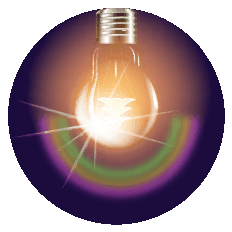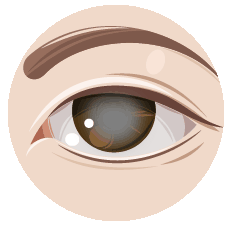


Glaucoma
Have you ever heard glaucoma referred to as the "silent thief of sight"? This is because in certain types of glaucoma, vision loss occurs without noticeable pain or symptoms, and once lost, vision cannot be restored. Causes and risk factors include high myopia or hyperopia, sleep apnea, and chronic migraines. Individuals with these conditions should undergo regular eye examinations. If glaucoma is detected, timely consultation with an ophthalmologist is essential. Early detection and management can help reduce the risk of permanent vision loss.
What is Glaucoma?
Glaucoma generally refers to damage of the retinal nerve fibers and optic nerve at the back of the eye caused by elevated intraocular pressure. However, some patients develop optic nerve damage even when their eye pressure remains within the normal range (10–21 mmHg), leading to visual field loss. In the early stages, glaucoma typically causes gradual loss of peripheral vision, eventually leaving only central vision. Without proper management, it may progress to significant vision loss or even complete blindness. Because glaucoma usually has no obvious symptoms, it is often difficult to detect until the visual field has narrowed, at which point the damage is irreversible. Women, particularly those who are middle‑aged or older, face a higher risk of acute glaucoma; however, even children can be affected.

Types of Glaucoma
Chronic Glaucoma

Acute Glaucoma

Primary and Secondary Glaucoma
Glaucoma

Causes of Glaucoma

Aged 40 or above
Aging plays an important role in glaucoma, as its prevalence increases exponentially with age. However, the pathophysiology of increasing age as a risk factor for glaucoma is unclear.

Family inheritance
While everyone can develop glaucoma, you may be at higher risk if glaucoma runs in your family. The most common form of glaucoma, open-angle glaucoma, is hereditary. If you have an immediate family member with glaucoma, your risk of developing the disease is 4 to 9 times higher.

History of eye injury
(especially blunt trauma)
If the eyeball is unfortunately hit head-on by a fast-moving hard object, it may cause bleeding of the iris and other structures, block the flow of aqueous humor, and cause an increase in intraocular pressure. With proper treatment, the optic nerve can be protected from permanent damage. However, if the structure near the ciliary body or trabeculae is damaged due to impact, it may affect the drainage system, causing long-term increase in intraocular pressure and inducing glaucoma.

High myopia/hyperopia
In addition to people with hyperopia who are prone to corner-angle closed glaucoma, high myopia is also one of the causes of chronic open-angle glaucoma. Studies have also pointed out that myopic eyes are more susceptible to increased intraocular pressure; if myopia of more than 400 degrees is accompanied by increased intraocular pressure, it is more likely to cause visual field defects.

Diabetes
The relationship between diabetes and open-angle glaucoma, the most common type of glaucoma, has intrigued researchers for years. People with diabetes are twice as likely to develop glaucoma as people without diabetes.

Sleep Apnoea
In recent years, literature research has pointed out that sleep apnea is related to glaucoma. It is possible that the patient's body is deprived of oxygen during sleep, which affects the blood circulation around the eyeballs, deprives the optic nerve of oxygen, and slowly degrades vision.

Chronic migraine
Glaucoma is generally divided into acute and chronic, and the obvious migraine pain is mostly acute glaucoma. Because the outlet channel of the anterior chamber of the eyeball is blocked in a short time, the eye pressure rises rapidly, and there is more often corneal hysteresis, causing severe head pain, so it is easy to be mistaken for head pain and delay mistreatment.

Cardiovascular disease
High blood lipids may also cause glaucoma. Although it does not directly cause eye disease, research statistics show that it does cause an increase in intraocular pressure, thereby increasing the risk of glaucoma.

Hypertension
Studies have found that patients with high blood pressure are twice as likely to suffer from "normal intraocular pressure glaucoma" as other people. This is because high blood pressure can damage the blood circulation regulation system of the eyeball and cause blood flow in the eyeball to be disordered. Therefore, although the intraocular pressure is normal, it will accelerate the withering of the optic nerve.

Increased eye pressure
due to steroid use
Steroid glaucoma is one of the sequelae of long-term use of steroids and is also considered a type of open corner glaucoma. Long-term use of steroids may cause the aqueous humor drainage hole of the eyeball to be blocked, resulting in a decrease in the drainage rate of aqueous humor and an increase in intraocular pressure. However, as long as the use of steroids is stopped, the intraocular pressure of most patients can drop to the normal range.
Symptoms of Glaucoma

No obvious sign and symptom in the early stage. Over time, the peripheral vision shrinks and the patient loses central vision.

Eye redness, seeing rainbow circles around lights, vision loss, eye pain, headache and vomiting, etc.
Glaucoma Management Methods

Statistics show that there are about 120,000 people in Hong Kong living with glaucoma, with approximately 5% of those aged over 40 affected. Although vision lost to glaucoma cannot be restored, early screening (such as assessing eye pressure and corneal health) and timely diagnosis, combined with proper management, can help prevent or slow down further vision loss.
| Treatment Plan | Principles of the Treatment Method | Degree of illness |
|---|---|---|
| Eye Drops | In the early stages of the disease, medication in the form of eye drops can be used to control the condition. These medications help protect and preserve the optic nerve tissue and its functions by lowering intraocular pressure to the appropriate target range, thereby reducing further nerve damage. The primary goal is to stabilize visual function. Compared with other treatment options, eye drops generally cause fewer serious side effects and are considered safer than surgery or laser therapy. | Early Management |
| Laser trabeculoplasty | By creating small holes around the iris, the flow of aqueous humor is promoted to reduce intraocular pressure. | Open‑Angle Glaucoma (Early Management) |
| Peripheral iridectomy | Laser is used to stimulate the drainage structure in the eye, increase fluid drainage, and help reduce intraocular pressure. | Open‑Angle Glaucoma (Mid‑Stage Management) |
| Selective laser trabeculoplasty | Lasers are used to repair specific mesh structures to promote drainage and reduce intraocular pressure. | Open‑Angle Glaucoma (Mid‑Stage Management) |
| Micropulse light cyclophotocoagulation | Micropulse light is used to irradiate the ciliary body tissue to reduce the production of aqueous humor to reduce intraocular pressure. | Patients with refractory glaucoma or those who require further intraocular pressure control |
Caution
Prolonged use of eye drops may cause dryness and redness in the eyes and may even cause allergy and discomfort.
Glaucoma FAQ
Does it have to be high eye pressure to have glaucoma?
No, there is a type of glaucoma called low-tension glaucoma, where the eye pressure is below 21mmHg (glaucoma is generally suspected when the eye pressure is above 21mmHg).
Could headache be caused by glaucoma?
Headaches can be caused by many different factors, and surprisingly, not all of them are related to the head itself. Some are actually linked to the eyes, a condition known as ocular headache. One common example is acute glaucoma. In this condition, the drainage angle of the eye suddenly becomes blocked, causing intraocular pressure to rise rapidly. This often leads to corneal edema and intense headache, which can easily be mistaken for migraine. However, delayed treatment may damage the optic nerve and even cause rapid vision loss. Therefore, if you experience persistent headaches, eye pain, worsening headache when pressing on the eye, blurred vision, or nausea, you should seek help from an ophthalmologist immediately.
How to detect early-stage glaucoma?
Because early-stage glaucoma has no obvious symptoms, it steals vision silently at any time. When you find that your field of vision is narrowed, irreversible damage has been done to your eyes. Therefore, it is recommended that adults undergo regular comprehensive eye examinations every one to two years to check intraocular pressure, cornea and other eye health conditions to avoid missing opportunities to control the disease.

